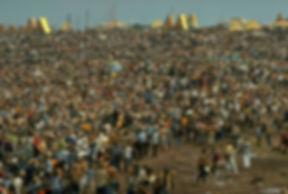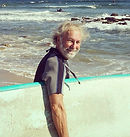
Here’s some interesting information that may explain “the origins” of the 1960s hippie movement. I hasten to add that, having no training in sociology, I can’t claim total accuracy. What is known is that back in the late 1800s in Germany there was a social movement called “naturmenschen” or nature men, who rejected industrialization and the “unnatural” trends of urbanization and who adopted a “back to nature” creed. In the early 1900s a few naturmenschen moved to the United States and settled in California. One was Hermann Sexauer, “a philosophical anarchist, a radical pacifist, a theoretical nudist, and an anti-communist,” who opened a natural foods store in Santa Barbara. Another was William Pester, who left Germany to avoid military service and settled in Palm Canyon, California. (That’s him sitting in front of his hut with what looks like a dobro on his lap. Photo supposedly taken in 1917.)
Next came John Richter, son of German immigrants, who believed in “transcendentalist philosophy, wearing long hair and a beard and eating only raw fruits and vegetables.” Richter opened the Eutropheon, a health food store on Laurel Canyon Blvd in Los Angeles, where a group of young men (where were the women?) hung out who would eventually be dubbed the “California Nature Boys.” Beat Generation author Jack Kerouac wrote in On the Road that he saw “an occasional Nature Boy saint in beard and sandals” while passing through L.A. in 1947.

Another seminal figure in the American hippie movement was eden ahbez (1908 – 1995) who adopted and promoted a lifestyle in California that became something of a blueprint for the future counter-culture of the 1960s.
ahbez eschewed capital letters in his name, claiming that only the words God and Infinity were worthy of capitalization. He was born in Brooklyn, NY and grew up in Kansas. During the 1930s, he performed as a pianist and dance band leader. In 1941, he arrived in Los Angeles and began playing piano in the Eutropheon, a small health food store and raw food restaurant on Laurel Canyon Boulevard. The cafe was owned by John and Vera Richter, whom I wrote about in the first installment of this hippie history thread. Like other proto-hippies of the time, the Richters followed a German Naturmensch and Lebensreform philosophy.

ahbez took to wearing sandals, shoulder-length hair, a beard, and white robes. For a while he camped out below the first L in the Hollywood Sign above Los Angeles and studied Oriental mysticism. He slept outdoors with his family and ate vegetables, fruits, and nuts. He claimed to live on three dollars per week.

Strangely, ahbez’s life took a non-hippish turn in 1947 when he approached Nat "King" Cole's manager backstage at the Lincoln Theater in Los Angeles and handed him the music for a song he’d written called, "Nature Boy" and then disappeared. Cole loved the song and began playing it for live audiences to much acclaim, but needed to track down its author before he could release a recording of it.
https://www.youtube.com/watch?v=Iq0XJCJ1Srw
ahbez was discovered living under the Hollywood Sign and became the focus of a media frenzy when Cole's version of "Nature Boy" shot to No. 1 on the Billboard charts and remained there for eight weeks. In early 1948, RKO Radio Pictures paid ahbez $10,000 for the rights to "Nature Boy" to use as the theme song for their film The Boy With Green Hair. He was credited as the song’s composer on the opening titles of the film.
Frank Sinatra and Sarah Vaughan later released versions of the song. ahbez continued to supply Cole with songs, including "Land of Love (Come My Love and Live with Me)", which was also covered by Doris Day and The Ink Spots. In the mid 1950s, he wrote songs for Eartha Kitt, Frankie Laine, as well as writing some rock-and-roll novelty songs. In 1957, his song "Lonely Island" was recorded by Sam Cooke, becoming the second and final ahbez composition to hit the Top 40.

Gypsy Boots was another of the proto-hippies who may have served as models for what was eventually labeled the “1960s counter culture.” They included Hermann Sexauer, “a philosophical anarchist, radical pacifist, and theoretical nudist,” who opened a natural foods store in Santa Barbara around 1916; William Pester, who left Germany to avoid military service and settled in Palm Canyon, California around the same time; John Richter, son of German immigrants, who believed in “transcendentalist philosophy, wearing long hair and a beard and eating only raw fruits and vegetables,” and opened the Eutropheon, a health food store on Laurel Canyon Blvd in Los Angeles, where a group of young men (where were the women?) hung out who would eventually be dubbed the “California Nature Boys.” One of them was eden ahbez, who eschewed capital letters in his name, claiming that only the words God and Infinity were worthy of capitalization, and camped out below the first L in the Hollywood Sign above Los Angeles. Oddly, he would eventually write songs for Nat “King” Cole, Earth Kitt and Sam Cooke.
Boots, whose given name was Robert Bootzin, was one of the nature boys, and may have been the first to invent the drink we now call the smoothie. Born in 1914, he dropped out of high school in the 1930s to wander California with other “vagabonds” and eventually settled in Tahquitz Canyon near Palm Springs, where he and others slept in caves and bathed in waterfalls. Decades ahead of the Hippie movement, Bootzin and his companions grew long hair and beards, lived a carefree existence and were seasonal fruit pickers. Later he opened a health food store, the "Health Hut" in LA, which was patronized by dozens of Hollywood celebrities in the early 1960s.
Bootzin received national exposure in 1955, when he appeared on Groucho Marx's TV show You Bet Your Life. Introduced as "Boots Bootzin," he espoused his philosophy of clean living, exercise, and healthy eating. Bootzin went on to become a regular guest on American television talk shows in the 1960s, appearing 25 times on The Steve Allen Show where he would often play up his role as a health advocate by swinging from a vine onto stage. It was on Allen’s show that he introduced a fruit health drink he called a smoothie."

